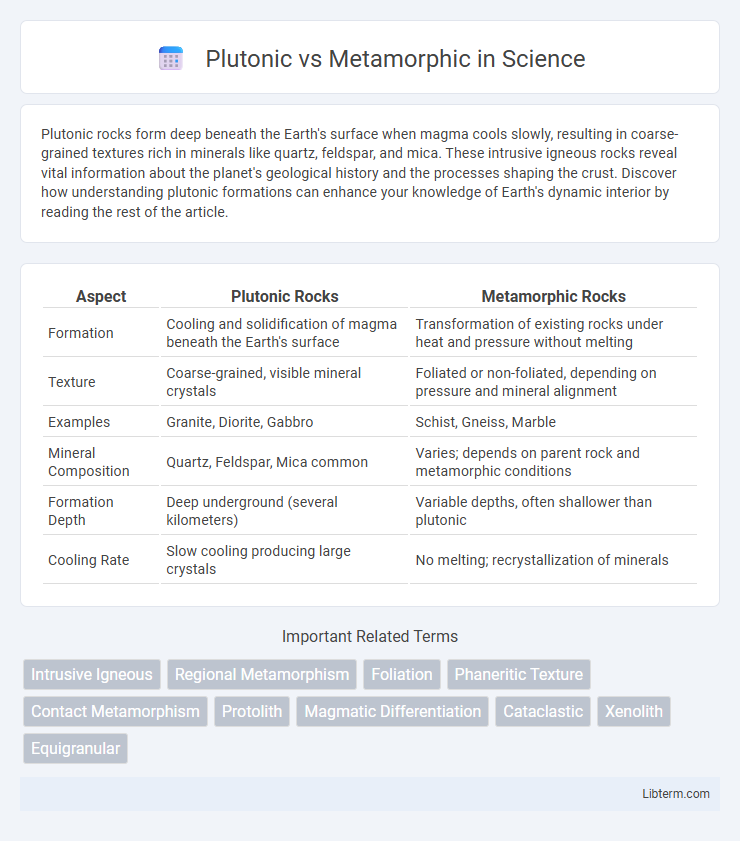Plutonic rocks form deep beneath the Earth's surface when magma cools slowly, resulting in coarse-grained textures rich in minerals like quartz, feldspar, and mica. These intrusive igneous rocks reveal vital information about the planet's geological history and the processes shaping the crust. Discover how understanding plutonic formations can enhance your knowledge of Earth's dynamic interior by reading the rest of the article.
Table of Comparison
| Aspect | Plutonic Rocks | Metamorphic Rocks |
|---|---|---|
| Formation | Cooling and solidification of magma beneath the Earth's surface | Transformation of existing rocks under heat and pressure without melting |
| Texture | Coarse-grained, visible mineral crystals | Foliated or non-foliated, depending on pressure and mineral alignment |
| Examples | Granite, Diorite, Gabbro | Schist, Gneiss, Marble |
| Mineral Composition | Quartz, Feldspar, Mica common | Varies; depends on parent rock and metamorphic conditions |
| Formation Depth | Deep underground (several kilometers) | Variable depths, often shallower than plutonic |
| Cooling Rate | Slow cooling producing large crystals | No melting; recrystallization of minerals |
Introduction to Plutonic and Metamorphic Rocks
Plutonic rocks form deep underground as magma cools slowly, resulting in coarse-grained textures, with granite being a common example. Metamorphic rocks develop from pre-existing rocks subjected to heat and pressure, causing mineralogical and structural changes without melting, exemplified by schist and gneiss. Understanding the formation environments distinguishes plutonic rocks' intrusive igneous origin from the solid-state transformation characteristic of metamorphic rocks.
Formation Processes: Plutonic vs Metamorphic
Plutonic rocks form through the slow cooling and solidification of magma beneath the Earth's surface, resulting in coarse-grained textures due to the extended crystallization period. Metamorphic rocks develop when existing rocks undergo physical and chemical changes under high pressure and temperature conditions without melting, often deep within the Earth's crust. These distinct formation processes differentiate plutonic igneous rocks, characterized by intrusive crystallization, from metamorphic rocks shaped by recrystallization and mineralogical transformation.
Key Characteristics of Plutonic Rocks
Plutonic rocks, also known as intrusive igneous rocks, are characterized by their coarse-grained texture formed from slow cooling of magma deep within the Earth's crust. Common examples include granite and diorite, which exhibit visible mineral crystals such as quartz, feldspar, and mica. These rocks are typically dense, hard, and have uniform mineral composition, differentiating them from metamorphic rocks formed through heat and pressure alteration.
Key Characteristics of Metamorphic Rocks
Metamorphic rocks form through the transformation of existing rocks under intense heat and pressure without melting, resulting in distinct foliated or non-foliated textures. Key characteristics include recrystallization of minerals, foliation caused by alignment of platy minerals like mica, and changes in mineral composition reflective of the metamorphic grade. Unlike plutonic rocks, which crystallize slowly from magma, metamorphic rocks display evidence of dynamic geological processes such as regional or contact metamorphism.
Mineral Composition Comparison
Plutonic rocks, such as granite and diorite, form from slowly cooled magma beneath the Earth's surface and typically contain large, visible crystals of quartz, feldspar, and mica. Metamorphic rocks, including schist and gneiss, arise from the alteration of existing rocks under heat and pressure, exhibiting minerals like garnet, staurolite, and kyanite that indicate recrystallization. The mineral composition in plutonic rocks reflects original igneous processes, while metamorphic minerals reveal new growth and mineral stability conditions during metamorphism.
Textural Differences Explained
Plutonic rocks crystallize slowly from magma beneath the Earth's surface, resulting in coarse-grained textures with visible mineral crystals such as granite and diorite. Metamorphic rocks develop from existing rocks subjected to heat and pressure, producing foliated or non-foliated textures characterized by mineral alignment or recrystallization, exemplified by slate and marble. Textural differences arise because plutonic rocks form through solidification of molten material, while metamorphic rocks recrystallize without melting, altering grain size and mineral arrangement.
Common Examples of Plutonic and Metamorphic Rocks
Granite and diorite are common examples of plutonic rocks formed from the slow crystallization of magma beneath the Earth's surface, characterized by coarse-grained textures. Metamorphic rocks such as schist, gneiss, and slate result from the transformation of pre-existing rocks under intense heat and pressure, displaying foliated or non-foliated textures depending on the mineral alignment. These rocks provide essential insights into geological processes, with plutonic types linked to igneous activity and metamorphic variants reflecting tectonic and thermal influences.
Geological Importance of Each Rock Type
Plutonic rocks, formed from the slow cooling of magma beneath Earth's surface, provide critical insights into the composition and processes of the Earth's interior, helping geologists understand tectonic activity and crustal formation. Metamorphic rocks, created through the transformation of existing rocks under heat and pressure, reveal important information about the conditions and history of mountain building, subduction zones, and regional metamorphism. Both rock types are essential for reconstructing geological histories and assessing mineral resources linked to Earth's dynamic processes.
Uses in Industry and Construction
Plutonic rocks, known for their coarse-grained texture and durability, are widely used in construction for building monuments, countertops, and insulation materials due to their strength and resistance to weathering. Metamorphic rocks, such as marble and slate, find extensive use in the industry for flooring, roofing, and decorative purposes because of their aesthetic appeal and enhanced hardness. Both rock types play crucial roles in industrial applications, with plutonic rocks preferred for heavy structural components and metamorphic rocks favored for their refined appearance and workability.
Identifying Plutonic vs Metamorphic Rocks in the Field
Plutonic rocks, such as granite, form from the slow cooling of magma beneath the Earth's surface, resulting in coarse-grained textures that are visible to the naked eye. Metamorphic rocks, like schist or gneiss, exhibit foliated or non-foliated textures formed by the alteration of pre-existing rocks under heat and pressure, often showing banding or mineral alignment. Field identification relies on observing grain size, texture, and mineral composition: coarse, interlocking crystals indicate plutonic origin, while foliation or recrystallization patterns suggest metamorphic processes.
Plutonic Infographic

 libterm.com
libterm.com